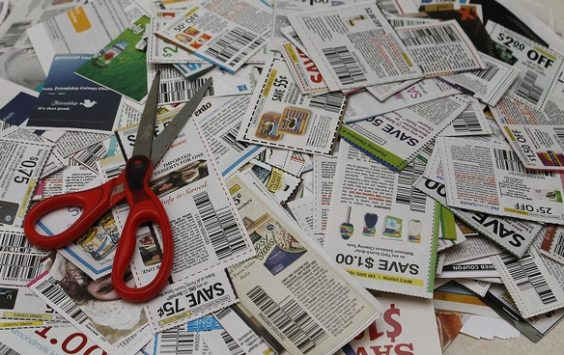
For most of this decade, the rate of coupon redemption has been on the decline. But the number of coupons actually available to use has held relatively steady during that time. Until now.
According to new figures released by Inmar, the number of coupons distributed and the number of coupons redeemed both declined sharply in 2018 – the former to a level not seen in a decade and a half, the latter to a level not seen in nearly half a century.
So at best, couponing is at a crossroads. At worst, it could be in crisis. If consumers and manufacturers are both losing interest in coupons at the same time, what’s to stop this steep decline from spiraling ever downward as both trends start to feed off each other?
The numbers tell the tale
Inmar’s latest Promotion Industry Analysis reveals that a mere 1.74 billion coupons were redeemed last year, down a steep 15.8% from 2017. Despite a modest rise during the Great Recession of the late 2000s and early 2010s, coupon use has been declining pretty consistently since 1992, when shoppers used a record 7.9 billion coupons. In 2018, we redeemed less than one-quarter the number of coupons used at couponing’s peak, and fewer coupons than at any time since the early 1970’s. At that time, however, there were far fewer coupons available to use – so one or two billion redeemed coupons represented up to 10% of all available coupons. Last year, a minuscule 0.65% of all coupons distributed were actually used – an all-time low.
While last year’s decline in coupon use is not unexpected, the corresponding decline in coupon distribution comes as more of a surprise. Inmar reports that 267 billion coupons were distributed last year, down a whopping 11.7% from 2017. In percentage terms, it’s the steepest single-year decline ever recorded. In actual numbers, it’s the fewest overall number of coupons available since 2003 and well off the peak of the 336 billion coupons that were distributed back in 2010.
So is last year’s coupon distribution figure an outlier, or are manufacturers just not interested in offering coupons anymore? There are a few possible explanations for the decline in the number of available coupons, which suggest that 2018’s decline may not be the last.
Distribution on the decline
One explanation is that manufacturers are simply choosing to spend more of their promotional dollars elsewhere, whether it’s because they find other promotional methods more cost-effective, or they’re simply tired of dealing with coupon fraud. Coupon budgets might be better spent on advertising, or in-store promotions. Or fewer discounts may be showing up in the form of coupons so that manufacturers can offer more discounts on rebate apps like Ibotta and Checkout 51.
Another reason is the continued decline in newspaper circulation, combined with the fact that many major newspapers don’t carry all of the coupon inserts anymore. Fewer people are buying or subscribing to their local Sunday paper, so there are fewer coupon inserts being distributed. The parent company of News America Marketing, which publishes the SmartSource inserts, reported last week that advertising revenues fell 7% at the end of last year “due to weak home-delivered revenues,” and warned that it expects “continued challenges” in the year ahead. This comes after persistent insert thefts and sales prompted coupon publisher Valassis to pull RetailMeNot Everyday and Procter & Gamble inserts from many big-city newspapers in the latter half of 2017, making 2018 the first full year to feel the impact. All of these changes result in fewer insert coupons making their way into the hands of shoppers who might use them.
The other explanation has to do with the growing adoption of digital coupons. Inmar reports that digital paperless coupons now make up 1.6% of all coupons distributed and 14.8% of all coupons redeemed. And digital coupons are redeemed at a higher rate than traditional newspaper insert coupons. 7.58% of digital coupons and 8% of print-at-home coupons that are offered are ultimately used, while only 0.28% of all insert coupons are used.
So, as Inmar explains, if a hypothetical manufacturer wants to issue a coupon that will result in about 11,000 sales, it could distribute 4 million insert coupons, a tiny percentage of which will be used – or it could offer just 150,000 digital coupons, which will be redeemed at a much higher rate. Both coupon offers would result in the same amount of redemptions. Multiply that by just over a hundred coupons shifted from the Sunday inserts to a digital coupon platform, and that’s half a billion coupons taken out of circulation right there.
So the decline in coupon distribution may be just a nod to efficiency. But the reasons for the decline in coupon redemption are more complex.
Coupons fall out of favor
A number of factors are believed to be contributing to the decline in the number of coupons used over the years. First and foremost is the state of the economy. Unemployment has been on the decline, while the stock market and consumer confidence have been on the rise for most of this decade. When the economy is doing well, fewer consumers feel the need to skimp and save by clipping coupons. There are also more shoppers buying store-brand products, or opting for meal kits over individual ingredients. Others are buying their groceries online, or at non-traditional grocery stores like ALDI or Costco, where manufacturers’ coupons aren’t even accepted.
And then there are the coupons themselves, which many shoppers simply don’t find enticing enough to bother clipping at all. Inmar found that two-thirds of the shoppers it recently surveyed said they can’t find coupons for the products they want to buy. And nearly as many complained that their coupons tended to expire before they had a chance to use them. Inmar found that expiration dates have indeed been approaching more quickly, with the average coupon expiring in 1.6 months, down 6.5% from the previous year.
One bright spot is that manufacturers have been offering higher-value coupons. The average coupon face value rose last year to $1.88, a new high. But purchase requirements also rose, which means you have to buy more items to get the same discount.
And if you want to use coupons to buy food to feed your family, you’re increasingly out of luck. Even though demand for food coupons remains high, only 27.2% of all coupons available in 2018 were for food items, a new low.
All of these factors make for coupons that many shoppers just aren’t all that interested in using. And then there’s the matter of much stricter coupon limits. When was the last time you handed your cashier a huge wad of coupons? These days, stores and manufacturers limit many coupons to four of the same type per shopping trip, or two, or even just one. The limits not only cut down on the overall number of coupons used, but they make couponing less enjoyable or even worth the effort – many shoppers who once considered themselves expert extreme couponers have cut back their coupon use significantly, or given up on couponing altogether.
What next?
So what will the year ahead bring? Couponers’ lack of interest, combined with the lack of coupons, could prove to be a troubling combination. Consumers will likely use fewer coupons if there are fewer coupons available – and manufacturers might make fewer coupons available if consumers seem determined not to use them. Unless one of these trends reverses, couponing itself as we know it may be in critical condition.
It could take a severe economic downturn to help revitalize interest in coupons – and no one wants that. So having fewer coupons to redeem, and fewer that you want to redeem, may be the new normal. Considering what it might take to turn things around, a decline in couponing is probably better than the alternative.











I’ve almost quit couponing altogether because of the ridiculous limits. I shop for a family of 12, which includes 5 kids ages 4 and under. For that many people, a limit of 2 toothpastes or 2 laundry detergents a week is not enough. Not to mention the ridiculous amounts like
.60 off 4 cans of beans or .75 off 2 bags of rice or .15 cents off a 5 pound bag of sugar. Also, the ridiculous prices of diapers. I haven’t seen a Huggies coupon in months and Pampers isn’t being too generous with their $3 off 2 packs that expire after 2 weeks. I started shopping at the commissary and getting commissary brands. It’s not as cheap as shopping with coupons and deals, but coupons aren’t that great anymore. It’s too bad a few had to ruin it for the rest of us.
Let me state the point again. It’s not that Trader Joe, Aldi and Costco don’t accept coupons. The point is that value still drives most shoppers more than anything else. And if you ask shoppers (last I saw) they intend to use coupons as much or more than last year.
My point on digital is based on verification. Paper goes through a physical count and reconciliation. Digital coupons (excluding printables) do not and as such it has always been more difficult to track despite what anyone claims.
Finally, on Ibotta, until these statistics capture cashback in their numbers I do not consider them meaningful. Cashback and coupons are interchangeable because the zero sum game is and has always been manufacturer budgets. The growth of cashback has not come from ad dollars. It has come from coupons. A more relevant picture is to report on all cash or points incentives redeemed.
The article failed to point out that when asked, shoppers say the opposite. They still shop for value (Trader Joe, Aldi and Costco) and still intend to use the same or more coupons. The apparent decline in coupons may also relate to two other factors. First, digital coupons are hard to track compared to paper. I suspect the numbers you’ve reported on are understated by several orders of magnitude. Second, there’s the rise of cashback which is not being tracked. Ibotta just reported $500M in savings.
Did you and I read the same article!? The article did, in fact, reference that people are shopping at retailers like Aldi and Costco who do not accept coupons. Likewise, it addressed digital rebate apps like Ibotta and C51. Lastly, your comment about digital coupons being hard to track makes no sense and is actually contrary to the reality that paper coupons are much harder to track, as most brands don’t get line of sight into anything regarding paper coupon redemptions — what product did the shopper buy when the coupon was used, which store was the coupon used in, etc.